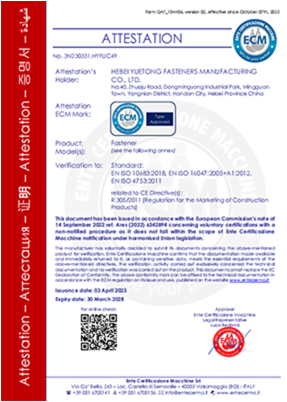9월 . 30, 2024 09:12 Back to list
Hexagonal Nut Locking Mechanisms for Secure Fastening Solutions in Engineering Applications
Understanding Hex Nut Locks A Comprehensive Guide
Hex nut locks, often referred to simply as locking nuts, play a crucial role in various mechanical and structural systems. These essential components are used to secure bolts and screws, ensuring the longevity and integrity of assemblies across diverse industries. This article provides an insight into hex nut locks, their types, applications, and benefits, highlighting why they are indispensable in modern engineering.
What Are Hex Nut Locks?
Hex nut locks are specialized nuts designed to prevent loosening under vibration and stress. The hexagonal shape of these nuts allows for easy tightening with a standard wrench, making them user-friendly and versatile. Typically made from durable materials such as steel, stainless steel, or nylon, they provide exceptional strength and resistance to corrosion. The locking mechanism of these nuts can vary, with different designs tailored to specific applications.
Types of Hex Nut Locks
There are several types of hex nut locks, each suited for different operational needs
1. Mechanical Lock Nuts These nuts employ physical features such as grooves, serrations, or additional locking elements that grip the bolt or screw threads. They can be reused multiple times without significant deterioration.
2. Locking Washers These are used in conjunction with standard hex nuts. The washer's design, often featuring external or internal teeth, prevents the nut from loosening by biting into the surfaces of both the nut and the underlying material.
3. Nylon Insert Lock Nuts (Nyloc Nuts) Incorporating a nylon insert that creates friction against the bolt threads, these nuts offer excellent resistance to vibration. The nylon component provides a reliable grip that prevents loosening, making them ideal for high-vibration environments.
4. Jam Nuts A jam nut is a thinner nut that is tightened against a standard hex nut, effectively locking it in place. This method is commonly used in applications where space is limited.
hex nut lock

5. Castle Nuts Featuring a series of slots or notches, castle nuts require a cotter pin to lock them in place. This design is often found in automotive and machinery applications where high levels of safety are required.
Applications of Hex Nut Locks
Hex nut locks are found in a myriad of applications across multiple sectors
- Automotive Engineering They are essential in securing components like axles, wheels, and engines due to their ability to withstand severe vibrations and shocks. - Construction In structural applications, hex nut locks ensure that bolts used in beams, bridges, and frames remain firmly in place under load. - Aerospace The high-stress environment of aircraft requires reliable fastening solutions, making nylon insert locks a popular choice in this industry. - Machinery Various machines utilize hex nut locks to maintain tight connections between moving parts, thereby enhancing overall performance and safety.
Advantages of Using Hex Nut Locks
The benefits of hex nut locks extend beyond mere functionality
1. Safety By preventing component loosening, these fasteners reduce the risk of accidents and failures. 2. Cost-Effectiveness Durable and reliable, hex nut locks minimize maintenance needs and replacement costs over time. 3. Ease of Use Their compatibility with standard tools ensures that they can be installed and removed with minimal effort. 4. Versatility The variety of hex nut locks available allows for tailored solutions that meet specific engineering requirements.
Conclusion
In conclusion, hex nut locks are vital components in various mechanical assemblies, renowned for their reliability and versatility. Understanding the different types of hex nut locks and their respective applications can significantly enhance the efficacy of engineering projects. As industries continue to evolve, the demand for robust fastening solutions like hex nut locks will undoubtedly remain a priority, ensuring safety and performance in an ever-advancing technological landscape.


